It wasn’t supposed to be like this. I came from a good family. I grew up fishing dry flies with bamboo rods on spring creeks. I learned all the latin names of aquatic insects and could tie patterns that imitated them right down to the last abdominal gill. I filled Wheatly after Wheatly with beautifully intricate flies made from exotic feathers and fur of animals most people never even heard of. But somewhere along the line, something went terribly, terribly wrong.
In the glory days of my fly fishing career, it was easy to “just say no” to vulgar synthetic materials and weighted nymphs. I enjoyed “pure” fly fishing with traditional dries made of natural materials. But soon, it wasn’t enough. My cravings for catching trout began to get the better of me. It started innocently enough. At first I used weighted nymphs socially (but not every day). I couldn’t ignore the fact that the added weight did help me sink the fly faster and catch more fish. But from there, it spiraled out of control until one day, I woke up in a pile of pearlescent Krystal Flash with chartreuse beads scattered all over my tying bench and no recollection of the last several hours of tying.
They say bead heads and brassies are gateways to more hardcore nymphing and crude flies. I knew I had to stop before I entered the seedy underbelly of tying egg flies or (even worse) sucker spawn. So, I got help from my local chapter of Nymphers Anonymous. With the support of the group, it wasn’t long before I kicked the beads and synthetics altogether and got my fly tying back to a sense of normalcy.
Years later, after I got into tenkara, I began to dabble with the more socially acceptable use of reverse hackle wet flies. They’re weren’t exactly the traditional, gossamer dry flies the purists back home sanctified, but at least I was off the weighted flies. That is, until Chris Stewart came along (or as I like to call him, “the enabler”). Chris was already a prominent tenkara angler in the US by the time I stumbled on to his site. At first glance, he seemed nice enough. With wire rimmed glasses, a grandfatherly beard, and a genial manner, Chris didn’t look anything like the burnt out glo bug junkies lurking in the shadows of the Salmon River. Little did I know that his moniker “Tenkara Bum” probably meant that he had lost everything to a life of hardcore killer bug use.
Nearly everywhere I looked on the internet, Chris was pushing the killer bug. At first, I ignored it and just stuck to my sakasa kebari. But it became harder and harder to resist. Curiosity started to get the better of me. Could any fly really live up to the mythical fish catching abilities he preached about? One day, in a moment of weakness, I broke down and tied some. I limited myself to just three. After all, I could handle just a few, right? I mean, it’s not like I’m going back to nymphing or anything. But the first time I fished them, it was all down hill.
The killer bug caught fish after fish when other patterns didn’t produce and I was immediately hooked. It was better than any weighted nymph I had ever tried. The legends were true! I began to tie more. Rather than starting the day with a dry or a sakasa kebari, I would immediately tie on a killer bug because I knew it would catch fish. Why bother taking a chance on anything else? Soon, I began to lose faith in all other patterns and the concept of a “one fly” philosophy didn’t seem so crazy anymore. Yet I had hoped that if I ever did convert to the one fly approach, it would be with a pattern far more elegant than a shapeless lump of yarn on a hook.
Since I’m known as a “tenkara angler”, maybe you can imagine the shame of having to carefully hide a stash of killer bugs beneath a layer of sakasa kebari in a dark corner of my fly box to avoid the scorn of my fellow anglers. It’s a shame I carry with me every time I set foot in the stream. That is, until the moment I hook that first of many fish for the day. 🙂
Cooking your Own
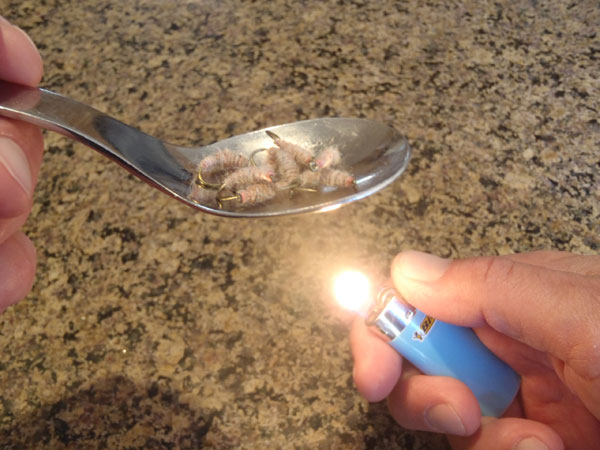
The Killer bug is tied in many variations. For instructions on how to tie the original pattern invented by Frank Sawyer (or to purchase some), visit Tenkara Bum’s killer bug page. One very effective version of the pattern is the Utah Killer Bug invented by Tenkara Guides LLC. I tie mine a little differently than either of these. Below are instructions for my take on the killer bug.
Materials
Hook: TMC 2457 (I only tie them is size #10 but you can tie them in any size)
Thread: Pink Uni 6/0
Weight: Medium Lead Wire
Body: Jamieson’s Shetland Spindrift Yarn Color #290 (oyster) Available here
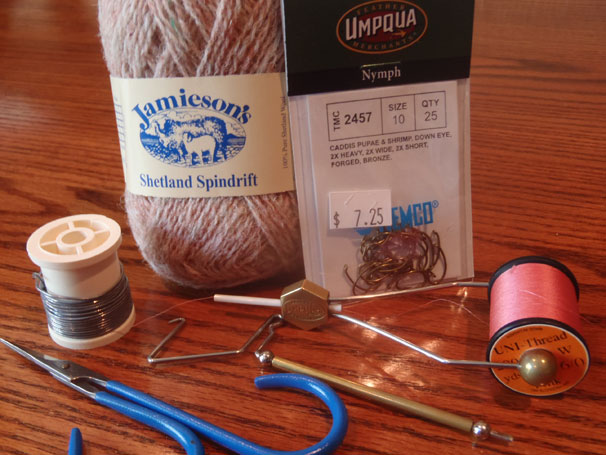
Step 1
Lay a base layer of thread on the hook.
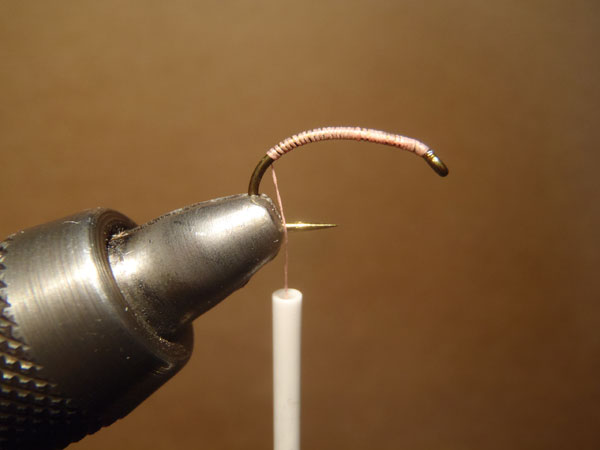
Step 2
In the center of the hook, wrap about 4-5 turns of lead wire.
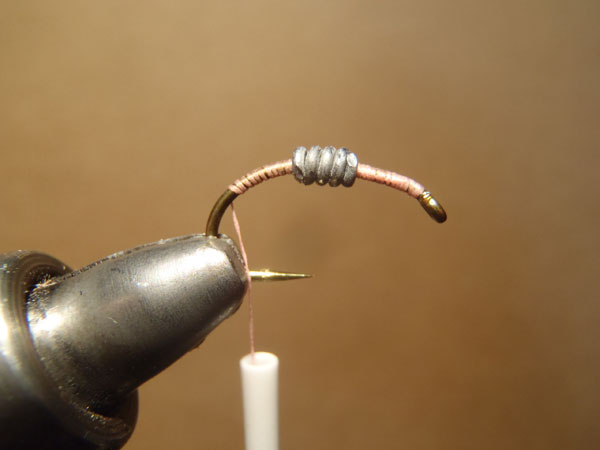
Step 3
Tie in about 6 inches of yarn at the bend of the hook behind the lead (you might use less or more depending on the size of the fly you’re tying).
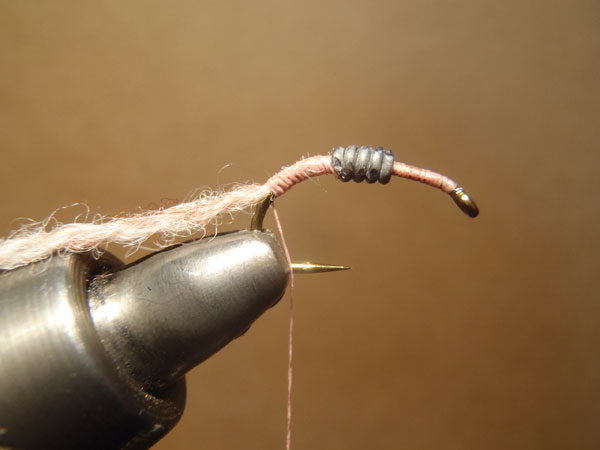
Step 4
Make a tapered underbody of thread that completely covers the thread. The yarn is translucent and when wet, the pink underbody will show through which I feel is an important part of the fly’s attraction. Notice that I like to tie mine with a very thick thorax. I also feel that fatter killer bugs are more effective than slender ones. When you’ve got a taper you like, advance the thread to the hook eye.
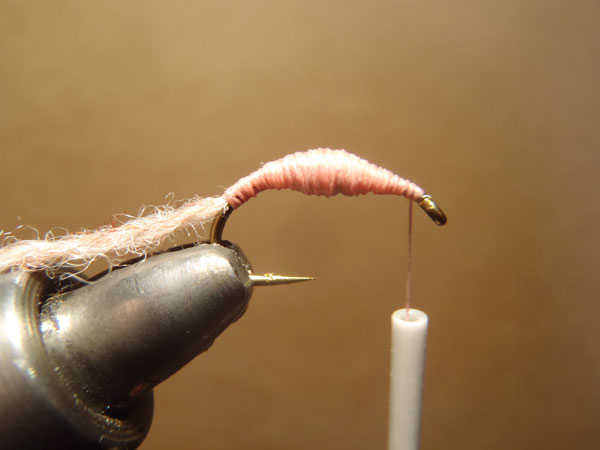
Step 5
Grab the yarn with your middle and index finger and twist it into a tight rope. You should notice that if you relax the tension, the yarn will want to twist up on itself. You only need to twist a few inches or so. You will twist more in the next step. Twisting the yarn not only adds durability to the fly, but also gives it a segmented look making it even “buggier”.
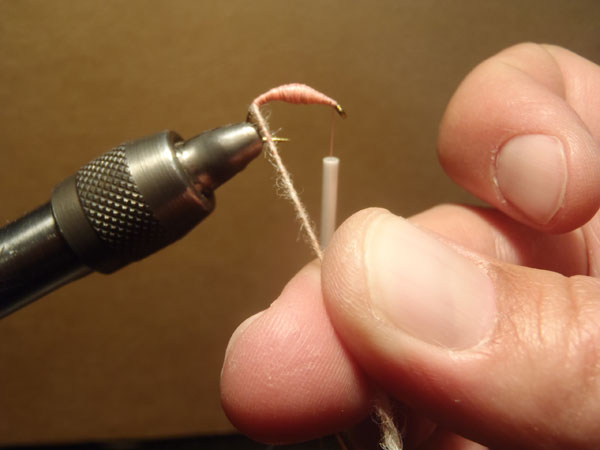
Step 6
Now, wrap the twisted yarn over the under body toward the hook eye. As mentioned above, you may have to keep twisting the yarn as you go. Tip: as you get closer to the eye, you may notice that the yarn wants to slip forward because the tread under body is slick. To prevent this, simply add a little dubbing wax to the underbody to make it tacky.
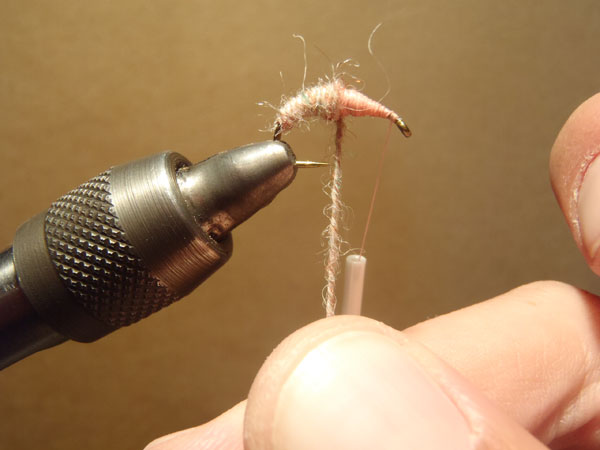
Step 7
When you get to the hook eye, tie off the yarn.
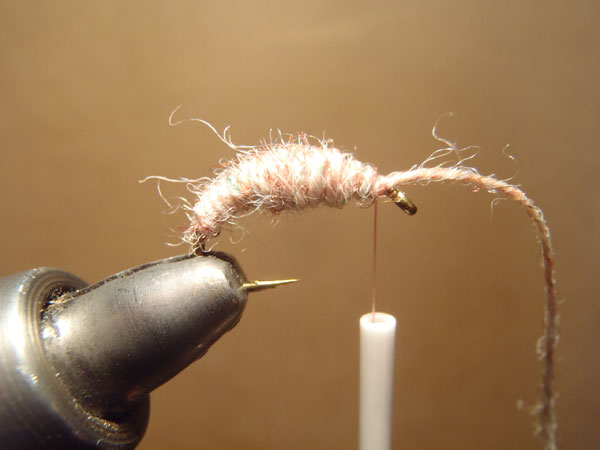
Step 8
Cut off the tag end of the yarn, build a head, whip finish and you’re done!
DISCLAIMER: These instructions are for educational purposes only. TenkaraTalk does not endorse killer bug use or abuse in any way, shape, or form.
WARNING: The use of killer bugs can be addictive. Side effects can include fishy smelling hands, tired arms, or broken rod tips. Discontinue use if wading becomes difficult due to a full creel or an overwhelming sense of euphoria. If you experience any of these symptoms, consult a British limestone dry fly purist immediately.


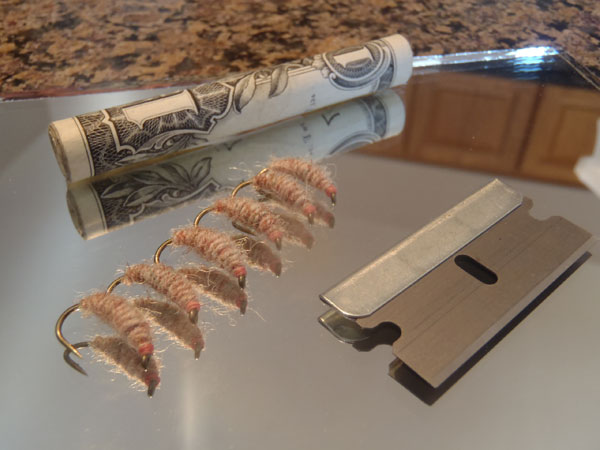
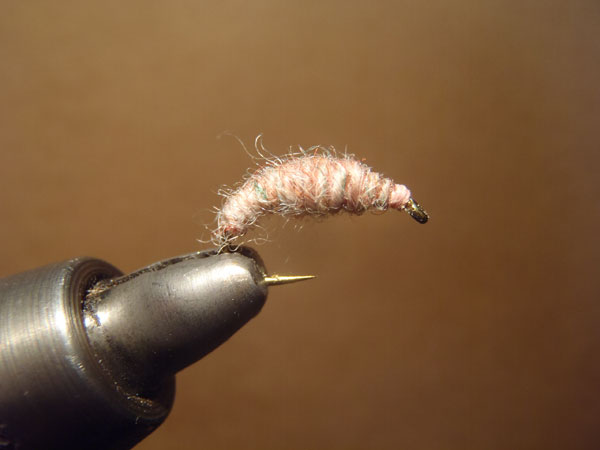






Wait until you start catching warm-water fish, like bass and bluegills on them.
Hello my name is tom and I’m a killer bug addict.
But I must say I like the way you tie them better than what I’ve been doing. I will be in even deeper now.
Hi TOM!
Thank you Jason for the very comprehensive tying photo’s and description. One question, why the use of lead wire? I thought that this was a no no environmentally. Oh, and if you want to fish Tenkara in warm water for bass or pan fish, just hop a plane to Texas, you’ll get all you want…
Hi Chris, just about everything today can be construed as a “no-no”. Personally, I don’t believe there is a significant environmental impact in using lead wire in flies. But for those who disagree, you could easily substitue non-lead wire. It’s usually lighter and won’t sink as fast so if you do, you might want to give it a couple of extra wraps.
love this post and the photos!!!
Jason do you fish the Killer bug on a 2 fly rig or by it’s self?
Hi Tom, I only fish one fly at a time. I don’t like fishing multiple flies because I feel that you can never present multiple flies as well as a single fly. Plus, they get more snags, tangles, can injure fish (and the angler) more easily, etc. Besides, this fly is so effective, I think one is enough. 🙂
I just recently received my first Killer Bug flies from Chris Stewart, the “Tenkara Bum”. I’m looking forward to getting hooked!
$7.25 for hooks???
Hmmm.. Oyster huh? I’m using “Sand” with the marker. how does “Oyster” colored yarn work for you?
Hi Matt. I like the color of the oyster better. And I like the fact that you don’t have to use the marker.
Do you seperate the yarn strands and use only 1 or do you all the strands at once?
Hi Rene, I do not separate the strands. I twist them clockwise all at once.
Great post again, Jason! I too am devoted to the bug, predominantly in its Utah Killer version; the famed Utah Killer Bug (UKB). I like a little tag of copper wire but I doubt the fish even notice it.
When I fished with ERiK of Tenkara Guides the UKB caught fish 2-3 to 1 over other flies. We also used a variant with a red Gamakatsu hook. This “Diablo” UKB was truly amazing!!
-Tom
Jason, I have been using the UTI thread in FL shell pink. You should see it under the UV light. It glows.
This is blasphemy! But It feels sooo good.
Nice post Jason. I like your simple variation. The step by step was a nice touch. Thanks.
JD
So I read your story. Tied a few and since the trout weren’t hitting the surface yesterday, tied one on… Nine fish later I was pretty happy, so I tied a bunch more last night. Is this the start of the addiction?
Yes. Turn back now before you start selling your plasma to buy more spindrift yarn! LOL glad it worked for you!
Aaagh! I’d just got clean of bead head Tenkara, and then this……y’all are going to suck me into the Killer Bug habit! 🙂
I’ve tied a few, but haven’t fished them yet; hopefully this next week I’ll get a few of them wet.
Excellent article, it could have been a dry shout out to a fly pattern, but instead you wrote a fun, engaging piece that pokes fun at all of us.
That’s a great looking bug and one that I have been imagining for quite some time! My mental engineering is now over thanks to this awesome step by step!!
I loved it! very Hunter S. Thompson. As your lawyer, I advise you to fish faster!
Gonzo fish blogging 🙂
Your confession makes me feel a little less sordid.
I love the way you’re tying it, that is without the copper. Thanks for sharing that, as they say.
High Ho, High Ho, off for some lead I go…(whistling away down the path)
Do I have the solution for you!!!
Ever heard of crystal flash or UV crystal flash dubbing? They come in various colors(yes I know it is syntethic). Hear me out now. Take the color pink or create from two different colors the color pink that you want to have. Use a thick wired caddis hook size 14 or 12. No lead or copper wire please!!!
Create a body of the dubbing in a cigarshape and then a partridge hackle. Reversed of course, it has to be a sakasa kebari! Now you have a fly which floats for a little while, treated with floatant it will float longer. But when it sinks, and crystal flash is a sinking materia, it will become partly transparrent. You can see the hookstem through the dubbing. This is how it should be because the killerbug looks a lot like a crustasean, which i believe is also meant to imitate that one according to Frank Saywer who invented the fly. The crustasean is in life also kind of transparant, just not always pink. Here is the trick why it should be pink. It atracts the fish. Crustaseans are often bothered by parasites that lay eggs inside them which creates a pink/orange spot. By doing this there is something happening with the crustaceans that makes them more floatable and therefor even more visible for the fish.( this is also the reason why so many czech nymphs have an orange spot in the middle)
But to get back to the fly. Because of the reversed hackle it floats and when it is sinking it is the material that makes it sinking and not the lead, which is more towards pure tenkara where weight should not be added on the flies if I am correct. The hackle gives you in this matter the option to fish it dry or wet with the pulsating movement.
I haven’t tried it out myself yet. But i have tried it in a brown color with a normal hackle of pardrige. When putting floatant on it, it will float and looks like a caddis waiting to emerge.
When it is sinking it looks like a caddis that is on its way up. That one is very succesfull. And I have a couple of pink nymphs which are really succesfull so why not combine it into a sakasa kebari? What do you think?
There’s always the risk of addiction when you learn from a Bum! 🙂
It’s great that everyone has their own variant of the K-Bug.
Seriously, a fun post, Jason. I enjoyed it!
– Jack 🙂
Jason — Your sense of humor and the ability to let it infect others is both rare and admirable. The spoonful of KBs was a hoot And your tying instructions aren’t too shabby either. Can’t wait for more.
Has anyone tried any other yarn colors? I’m thinking of a light olive using maybe the Moorgrass #286 Jamieson yarn.
We do that i Sweden but it is not a “Killer bug” any more:-)
http://www.pelles-fiske.se/ammeraan/enklare.html
Regards!
Peter
Hey Jason,
I really like this post ! So cool plus the tying instructions which are great.
I am not much of a nymph angler, so Is it possible for you to explain how to fish a killer bug.
I guess you use a parallel hi-viz line ? dead drift in currents ? you feel the take in the hand ? or see the line moves ?
Many thanks for your blog, I keep reading it for months now, it is nice when you are far from the waters …
Jason,
I was wondering if you had a particular rod that you like to use with these weighted flies?
And as mentioned in other posts, this is a well written, humorous article with excellent tying insructions…thanks!
Hi JC. I just use whatever rod I happen to be using that day. Nothing special. But many say that a stiffer rod works better for weighted flies.
I think I’m the last one to get hooked but hooked none the less… I like ’em both kebari style and no hackle.
Hi Jason,
Great post. Loved it. Good timing to. I just got together a few weeks ago with Tenkara Guide Matt Ship to fish the Kinni Kinnic in River Falls, WI. When things cooled off on the traditional Sekasa Kebaris in the afternoon, I pulled out a trusty Killer bug (not sure if it was on of Chris’s or the Utah Killer bug). Matt mentioned he’d never tried one and asked if I had much success with them. I told it’s my go to fly in the spring and when the fishings slow. I proceed to catch the next 5 browns and I think I also missed 2 hits. I gave Matt a couple to try out for himself.
Glad to here it Jeff. It’s called “killer” for a reason.
I tie my Killer Bugs with Lion Brand Wool-Ease Yarn in Blush Heather 104. It’s inexpensive and available everywhere. I wrap the hook first with a bit of copper wire for weight. Can’t keep them off!
New Tenkara neophyte, long time fly fisher/tyer/rod builder. Love this article, well done. Now I have to tie some of these.
A young fellow new to fly tying sent me a link to this site. The fly you are heralding as a killer has been used, in a slightly different style, in Pennsylvania for decades. It is called a “Walt’s Worm”. Google it and you will see how closely it resembles the Killer Bug. It resembles a crane fly larvae. I consider it akin to a “Green Weenie” or sucker spawn on the scale of tying difficulty and embarrassment in letting anyone know I’ve stooped so low. Might as well use a salmon egg.
Nice to see all you guys converting to that tenkara technique. I hope more fly fishers flip and eschew their traditional rods for tenkara so there is more room on the rivers I love to fish that just don’t lend themselves to casting 20′ and landing large trout that want to run at least 100′.
Hey Matt,
From your comments, I can tell you have no experience with tenkara, so let me clarify something for you. Tenkara was designed for small trout on small streams–not the situation you describe. Would you denounce a 3 wt. rod because it can’t land a 100 lb. tarpon? Would you consider a putter useless because you can’t make a 90 yard drive with it? Of course not. The right tool for the right job. And tenkara is extremely effective at what it was designed for–small streams, small trout (i.e. streams where you don’t have to make 20′ casts and the fish don’t run 100 ft.).
And as far as “stooping so low”, do you use a strike indicator? Because we don’t in tenkara. In fact, some might call that “bobber fishing” or “bait fishing” too.
> just about everything today can be construed as a “no-no”.
> Personally, I don’t believe there is a significant environmental
> impact in using lead wire in flies.
I heartily agree, Jason; a person need only try scraping his or her truck battery terminals and see how long it takes for the bright, chemically active lead to become coated with the comparatively inert, dull-looking, harmless lead oxide. Or pick up that lead tying wire spool and see if the wire is shiny (which would mean the lead is exposed to the environment) or whether it’s dull (which it is, which means it’s already coated in the lead oxide compound that is as non-reactive as the polymer coatings they use on split shot to comply with new laws).
To support that, realize that there is no measurable lead dissolved into waters as a result of a century or more of fishing. The laws usually cite the hypothetical conjecture that creatures “might be accidentally scooping up a lead pellet now and then and injesting it.” I’ve never caught a fish by leaving a fly in the bottom gravel until it’s shoveled up and swallowed. They might be more concerned about birds, but again birds aren’t going to swallow a loose fly , and if one does, the hook is the first thing it’d have to worry about. Trying to imagine a negative effect of a bit of lead wire on a hook shank that’s then completely covered by thread and yarn and epoxy and head cement is an exercise in arriving at a conclusion first and then seeking to support it with whatever sounds good on the state senate floor.
The only real reason I can see to comply with latest anti-lead-fly laws is to avoid having one’s gear confiscated and end up under a game warden’s Christmas tree for his twelve-year-old son. I believe such anti-lead-fly laws are over-reactions based (as usual) on political actions taken in absence of any scientific understanding. (I guess such laws are proposed by people who think the word “nuclear” is pronounced “nukuler” and who think the microwave makes food radioactive.) I suspect the real goal was to ban large amounts of lead pellets sprayed from shotguns, and to make such laws stick they had to artificially include fly fishing in them. That’s just a guess.
Well, my opinions. If the laws exist we must obey them…until such time as we can educate our lawmakers. That’s our job. The protectionist attitude is of course commendable and all we need now is to stick with real data and our streams should be fine. 🙂
I very much like the simplicity of the Killer Bug!
All good points Mike and I think you’re probably right.
Excellent article about building the killer bug. Jameson’s yarn is available at knitting stores in numerous colors. Besides the Oyster #290 I also use 301 Salmon, 147 Moss, 722 Mirage and 268 Dog Rose. Todd Myers, Arvada, CO
Woow!! i really enjoy reading the description jason, it was almost like reading a novel, the truth is that now im so courious about trying the killer bug….
Thanks Everth!
Great post I planning some Tankara next season,it sounds well suited to the places I fish.ATB Steve.
It looks very easy tying this fly. It it is really effective as the name that will be fantastic. I am going to try it.
I’ve hesitated asking this question for a couple months. Please don’t shoot or tase me, I respect and have practiced ALL methods of fishing!
The first thing that entered my feeble mind when I went to the Killer Bug page was its resemblance to a wax worm.
Well, here goes…in the spirit of keiryu, but perhaps not tenkara, why not just thread a wax worm on a #6 or 8 hook, beaded or not, and be done?
Hi,
Very nice and practical flies and very useful details about the actual tying. So inspiring. I wonder if you have had or have heard of anyone using the Killer Bug for salmon?
Kind regards all the way from Denmark.
Wayne, dynamite works too.
My name is Al, I’m a killer bug er
Your crazy!!! I luv it, we would get along great on a creek. I could share some real stories.
I caught 73 fish in less than three hours yesterday on the Tenkarabum Utah Killer Bug . Mixed bag of bluegill, crappie, shad and other sunfish. Love that fly!
Guess I am addicted now. ….
I also tie my UKB like Jason has described but I also tie in a small collar of hot pink ice dub. Gives it a bit more flash imo. Thanks for the article. It was well written and entertaining.
Thanks Ken, this is how I tie them today: https://www.tenkaratalk.com/2019/04/the-shetland-killer/
Loved the article!,
Thanks Sebastion! Check this one out too: https://www.tenkaratalk.com/2019/04/the-shetland-killer/